
Huperzia is a genus of lycophyte plants, sometimes known as the firmosses or fir clubmosses; the Flora of North America calls them gemma fir-mosses. This genus was originally included in the related genus Lycopodium, from which it differs in having undifferentiated sporangial leaves, and the sporangia not formed into apical cones. The common name firmoss, used for some of the north temperate species, refers to their superficial resemblance to branches of fir (Abies), a conifer. As of 2020, two very different circumscriptions of the genus were in use. In the Pteridophyte Phylogeny Group classification of 2016, Huperzia is one of three genera in the subfamily Huperzioideae of the family Lycopodiaceae. Most species in the subfamily are placed in the genus Phlegmariurus. Huperzia is left with about 25 species, although not all have been formally transferred to other genera. Other sources recognize only Huperzia, which then has about 340 species.

The Lycopodiaceae are an old family of vascular plants, including all of the core clubmosses and firmosses, comprising 16 accepted genera and about 400 known species. This family originated about 380 million years ago in the early Devonian, though the diversity within the family has been much more recent. "Wolf foot" is another common name for this family due to the resemblance of either the roots or branch tips to a wolf's paw.

Lycopodium is a genus of clubmosses, also known as ground pines or creeping cedars, in the family Lycopodiaceae. Two very different circumscriptions of the genus are in use. In the Pteridophyte Phylogeny Group classification of 2016, Lycopodium is one of nine genera in the subfamily Lycopodioideae, and has from nine to 15 species. In other classifications, the genus is equivalent to the whole of the subfamily, since it includes all of the other genera. More than 40 species are accepted.

Lycopodiella is a genus in the clubmoss family Lycopodiaceae. The genus members are commonly called bog clubmosses, describing their wetland habitat. The genus has a cosmopolitan distribution, with centers of diversity in the tropical New World and New Guinea. In the past, the genus was often incorporated within the related genus Lycopodium, but was segregated in 1964. In the Pteridophyte Phylogeny Group classification of 2016, Lycopodiella is placed in the subfamily Lycopodielloideae, along with three other genera. In this circumscription, the genus has about 15 species. Other sources use a wider circumscription, in which the genus is equivalent to the Lycopodielloideae of PPG I, in which case about 40 species and hybrids are accepted.
Ground pine or ground-pine may refer to:

Diphasiastrum complanatum, common names groundcedar, creeping jenny, or northern running-pine, is a species of clubmoss native to dry coniferous forests in colder northerly parts of the world. Under the original name Lycopodium complanatum, this was an inclusive superspecies that included a number of other species now known to be biologically separate. This plant is an evergreen, perennial pteridophyte. The spores are produced June to September.
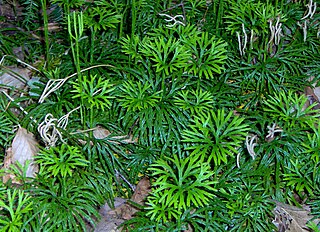
Diphasiastrum digitatum is known as groundcedar, running cedar or crowsfoot, along with other members of its genus, but the common name fan clubmoss can be used to refer to it specifically. It is the most common species of Diphasiastrum in North America. It is a type of plant known as a clubmoss, which is within one of the three main divisions of living vascular plants. It was formerly included in the superspecies Diphasiastrum complanatum. For many years, this species was known as Lycopodium flabelliforme or Lycopodium digitatum.
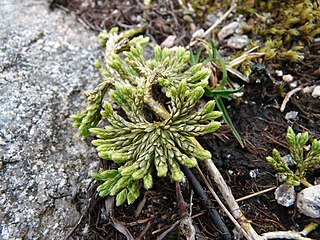
Diphasiastrum alpinum, the alpine clubmoss, is a species of clubmoss. This plant is a glaucous scale-leaved perennial pteridophyte. In Finland, the spores are produced June to September. It was first described by Carl Linnaeus in his Flora Lapponica, 1737, from specimens obtained in Finland.

Austrolycopodium magellanicum, synonym Lycopodium magellanicum, the Magellanic clubmoss, is a species of vascular plant in the club moss family Lycopodiaceae. The genus Austrolycopodium is accepted in the Pteridophyte Phylogeny Group classification of 2016, but not in other classifications which submerge the genus in Lycopodium.

Diphasiastrum sitchense, the Sitka clubmoss, is a pteridophyte species native to northern North America and northeastern Asia. It is a terrestrial herb spreading by stolons running on the surface or the ground or just slightly below the surface. Leaves are appressed, broadly lanceolate, up to 3.2 mm long. Strobili are solitary on the ends of shoots. It is known from every province in Canada, plus the US States of Alaska, Oregon, Washington, Idaho, Montana, Maine, New Hampshire, Vermont, and New York. It is also found in Greenland, St. Pierre and Miquelon, Yukon, Japan, and the Kamchatka Peninsula of Asiatic Russia. It can be found in alpine meadows, open rocky barrens, and coniferous woodlands.
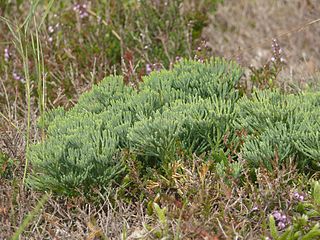
Diphasiastrum tristachyum, commonly known as blue clubmoss, blue ground-cedar, ground pine, deep-rooted running-pine or ground cedar, is a North American and Eurasian species of clubmoss. In North America, it has been found from Newfoundland west to Manitoba, and south as far as Georgia and Alabama. In Eurasia, it ranges from southern Norway and Sweden south to France and Italy and it also occurs in the Caucasus.
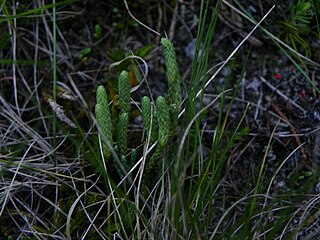
Diphasiastrum × issleri, known as Issler's clubmoss, is a hybrid species of clubmoss known from northern Europe and a few historical collections in northern Maine.

Austrolycopodium is a genus of lycophytes in the family Lycopodiaceae. In the Pteridophyte Phylogeny Group classification of 2016, it is placed in the subfamily Lycopodioideae. Some sources do not recognize the genus, sinking it into Lycopodium. Austrolycopodium species are mostly native to the temperate southern hemisphere.

Diphasium is a genus of lycophytes in the family Lycopodiaceae. In the Pteridophyte Phylogeny Group classification of 2016, it is placed in the subfamily Lycopodioideae. Some sources do not recognize the genus, sinking it into Lycopodium, others include it in Diphasiastrum. Diphasium species are mostly native to the temperate southern hemisphere, but extend northwards into Central America and the Caribbean.
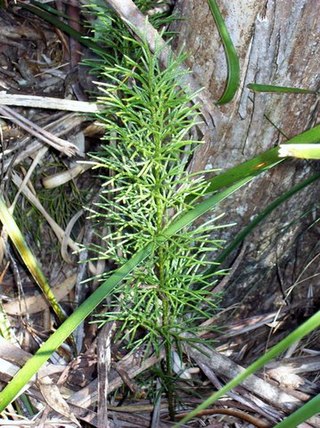
Pseudolycopodium is a genus of lycophyte in the family Lycopodiaceae with only one species, Pseudolycopodium densum, known as the bushy clubmoss. In the Pteridophyte Phylogeny Group classification of 2016, the genus is placed in the subfamily Lycopodioideae. Some sources do not recognize the genus, sinking it into Lycopodium. Pseudolycopodium densum is native to Australia, the North Island of New Zealand and New Caledonia. It is a spore-bearing vascular plant and grows up to a metre high. It is found in a wide variety of situations, often in high rainfall areas on sandy soils.

Lycopodioideae is a subfamily in the family Lycopodiaceae in the Pteridophyte Phylogeny Group classification of 2016. It is equivalent to a broad circumscription of the genus Lycopodium in other classifications. Like all lycophytes, members of the Lycopodioideae reproduce by spores. The oldest fossils of modern members of the subfamily date to the Early Cretaceous.
Diphasiastrum multispicatum, synonym Lycopodium multispicatum, is a species of plant of the genus Diphasiastrum in the family Lycopodiaceae. As of March 2024, Plants of the World Online used a broader circumscription of the genus Lycopodium, treating this species as Lycopodium multispicatum.















